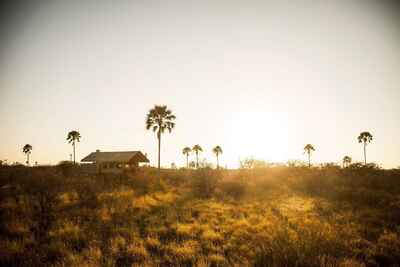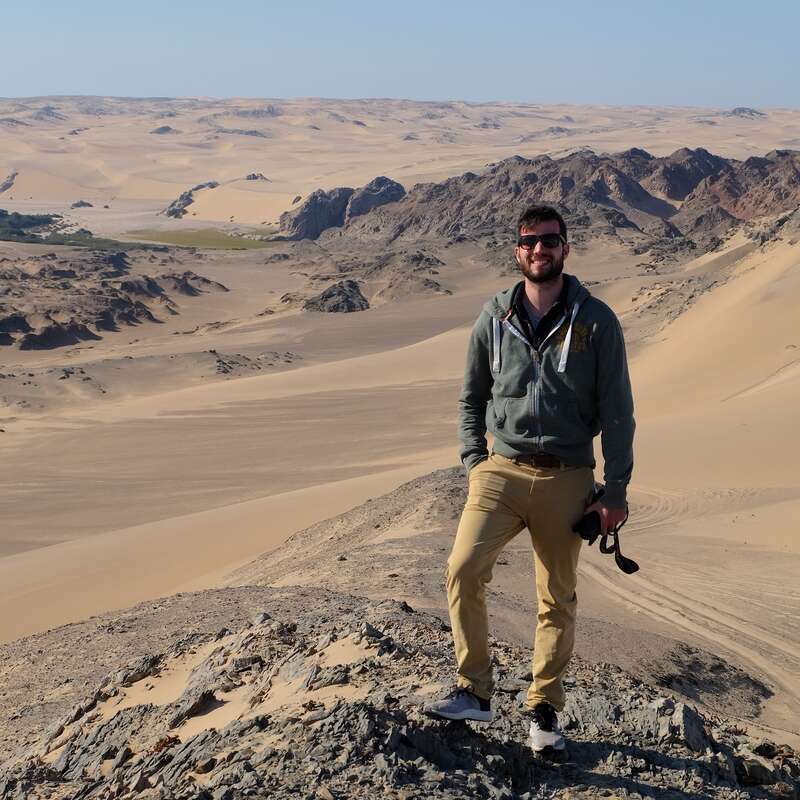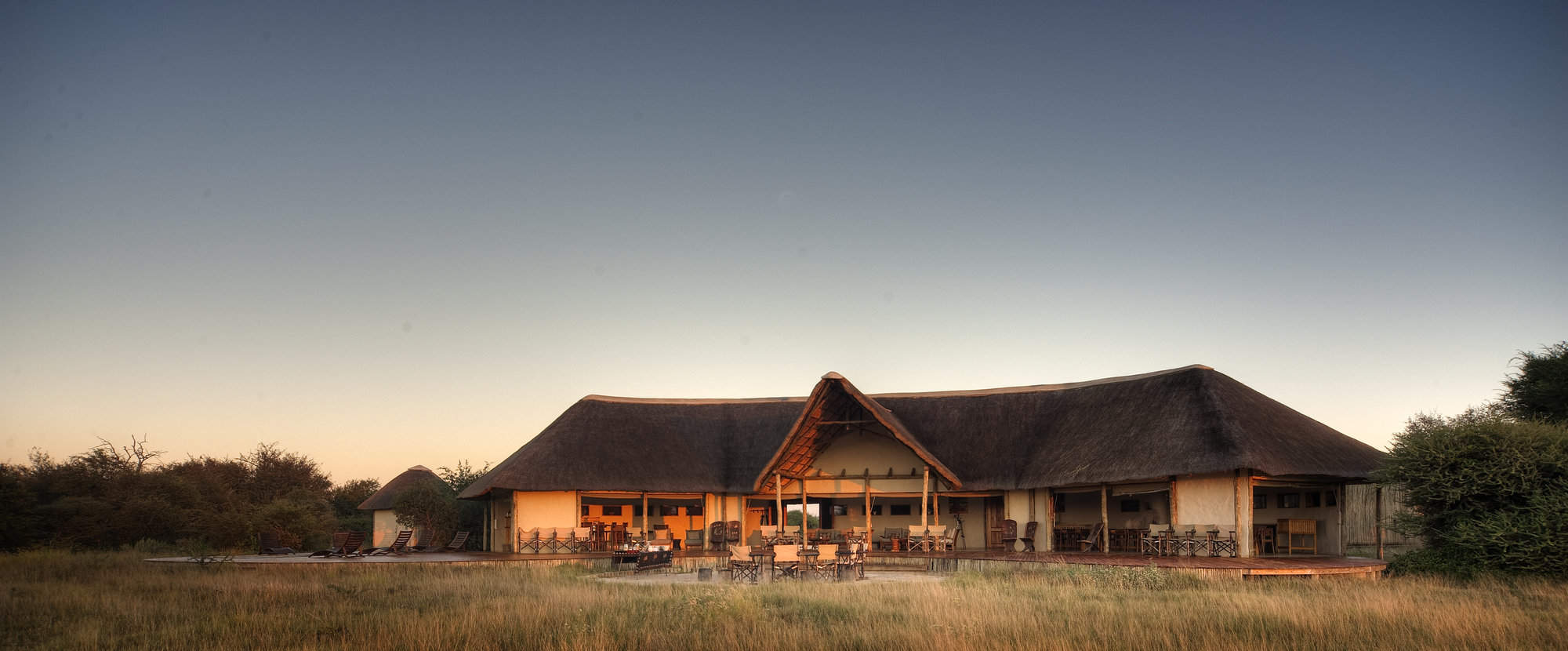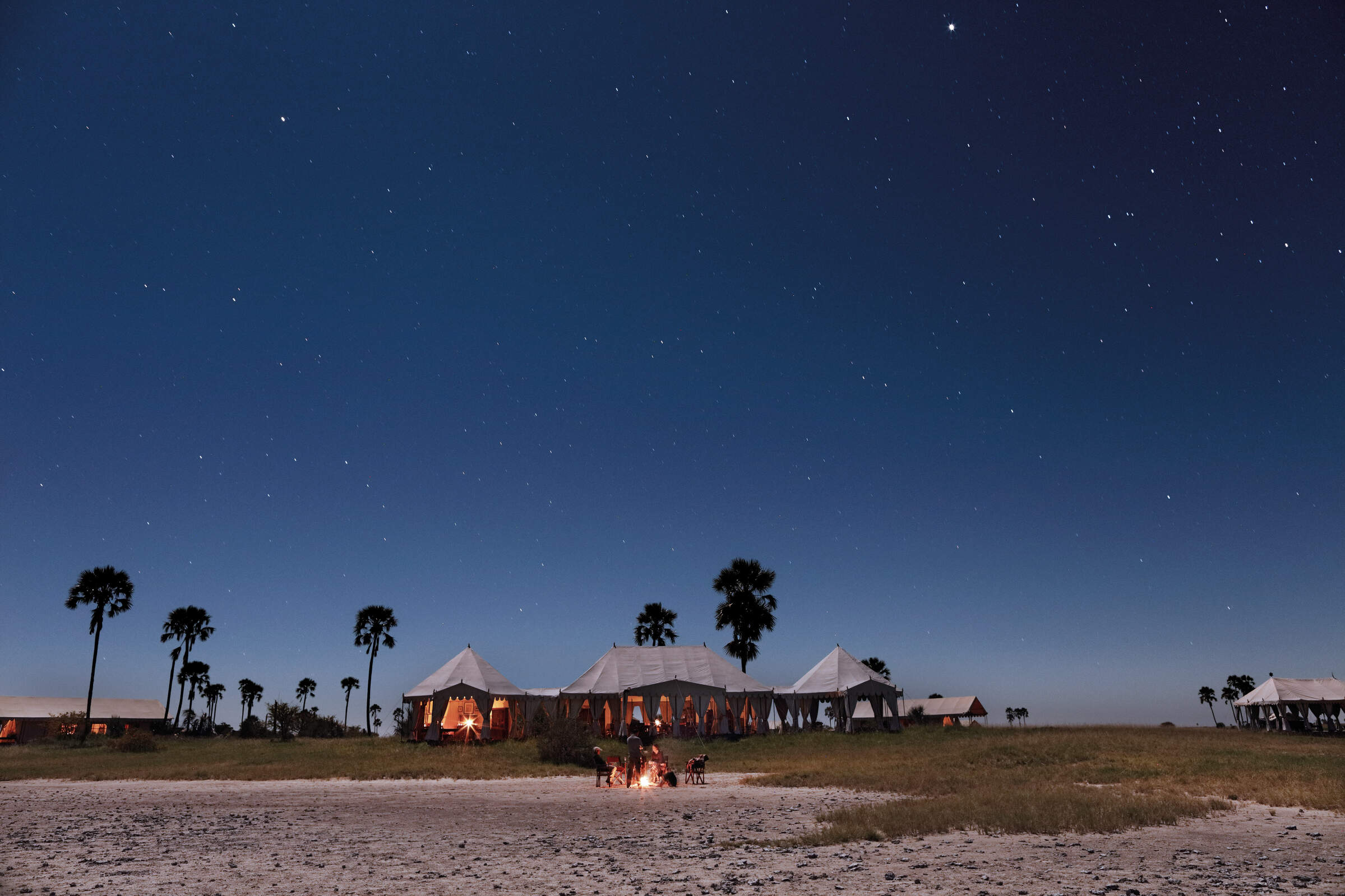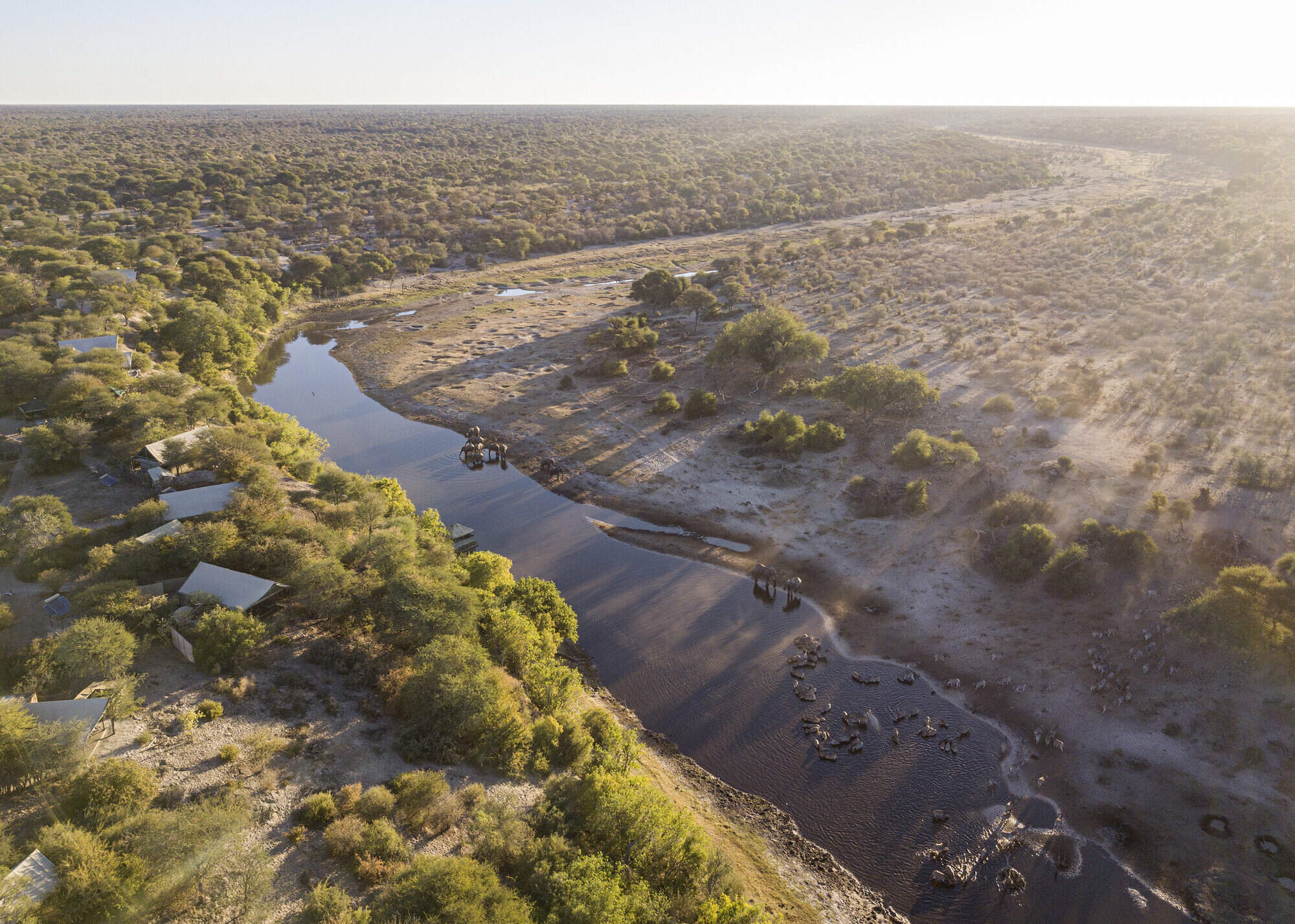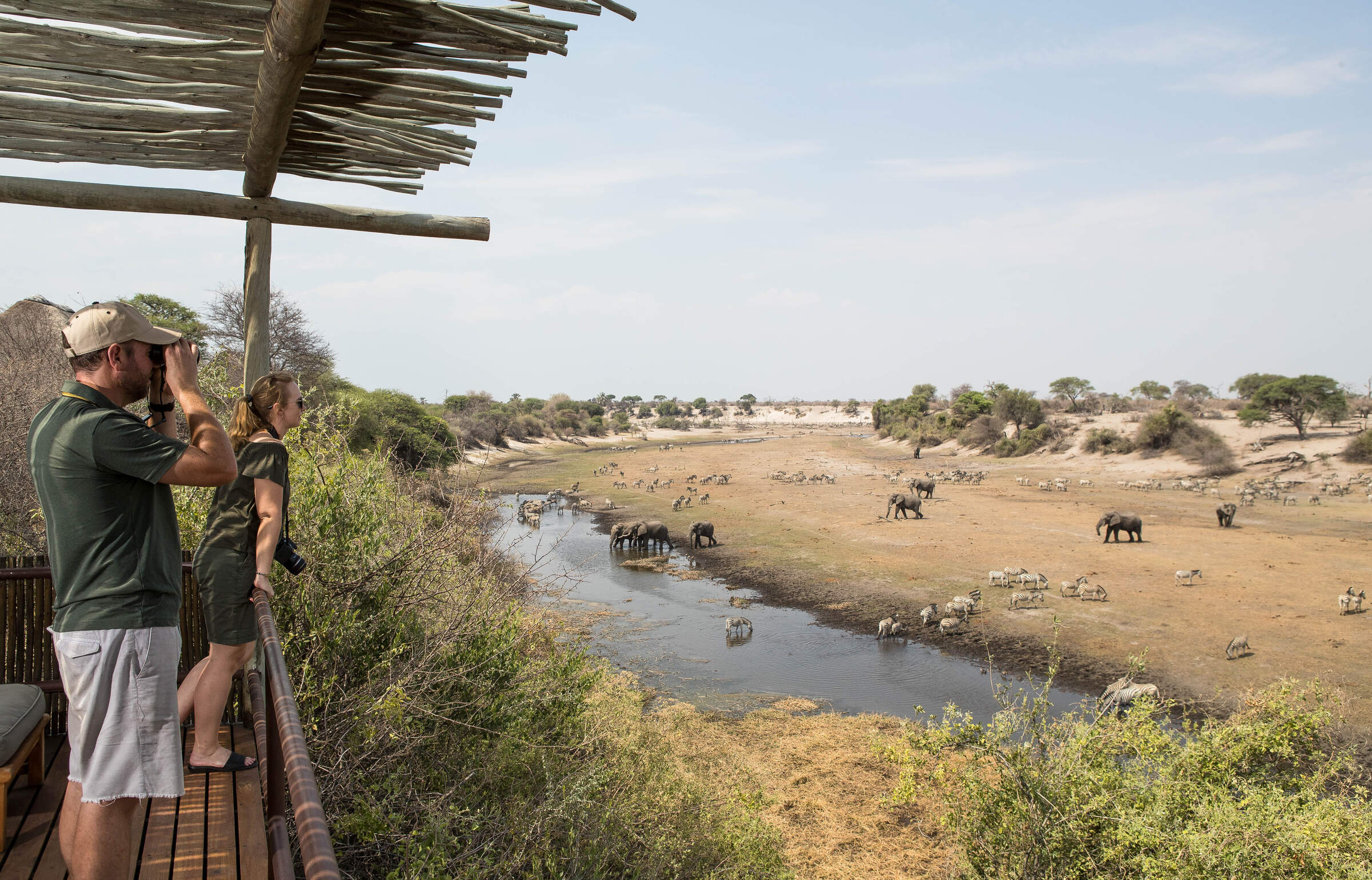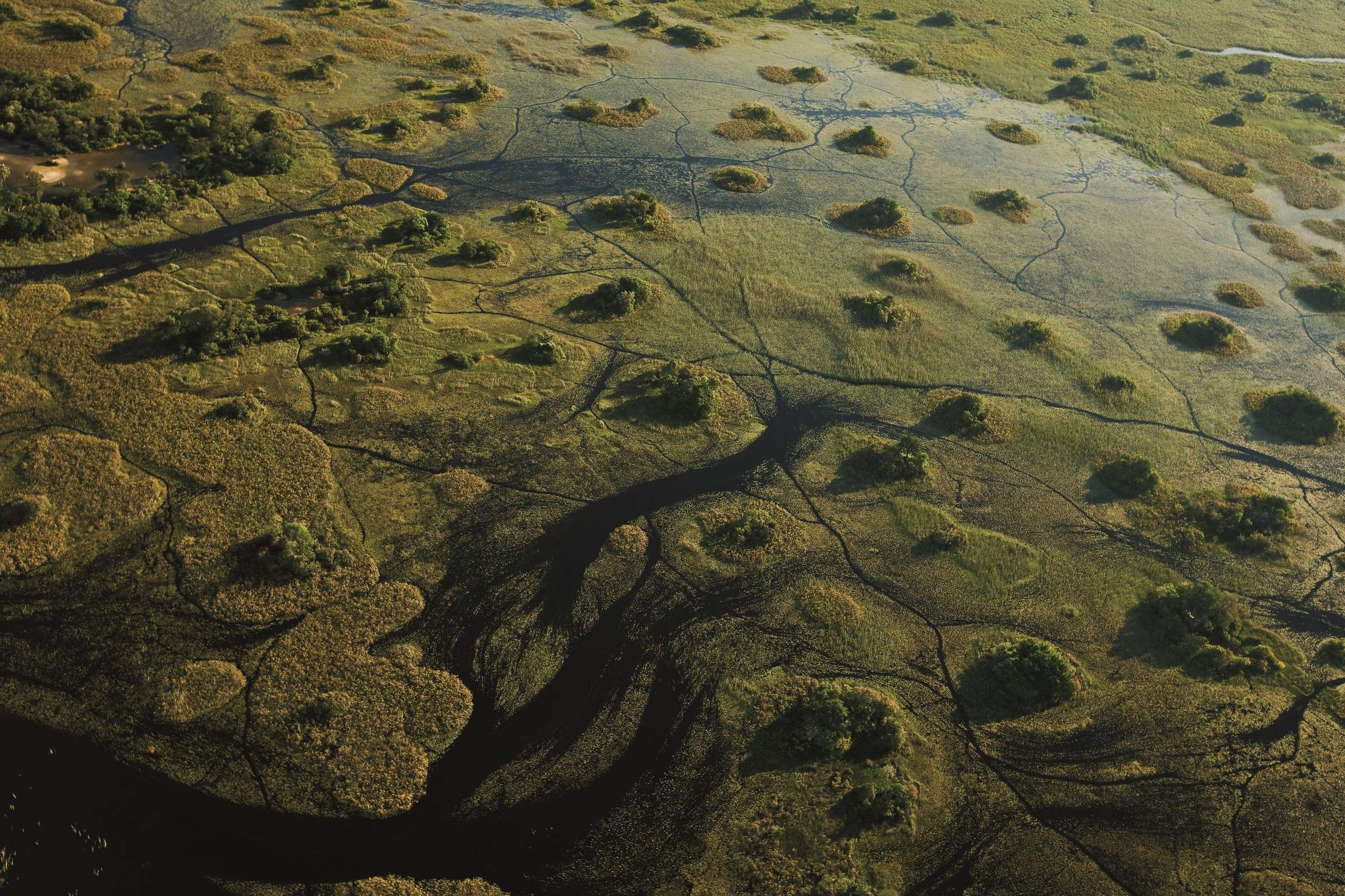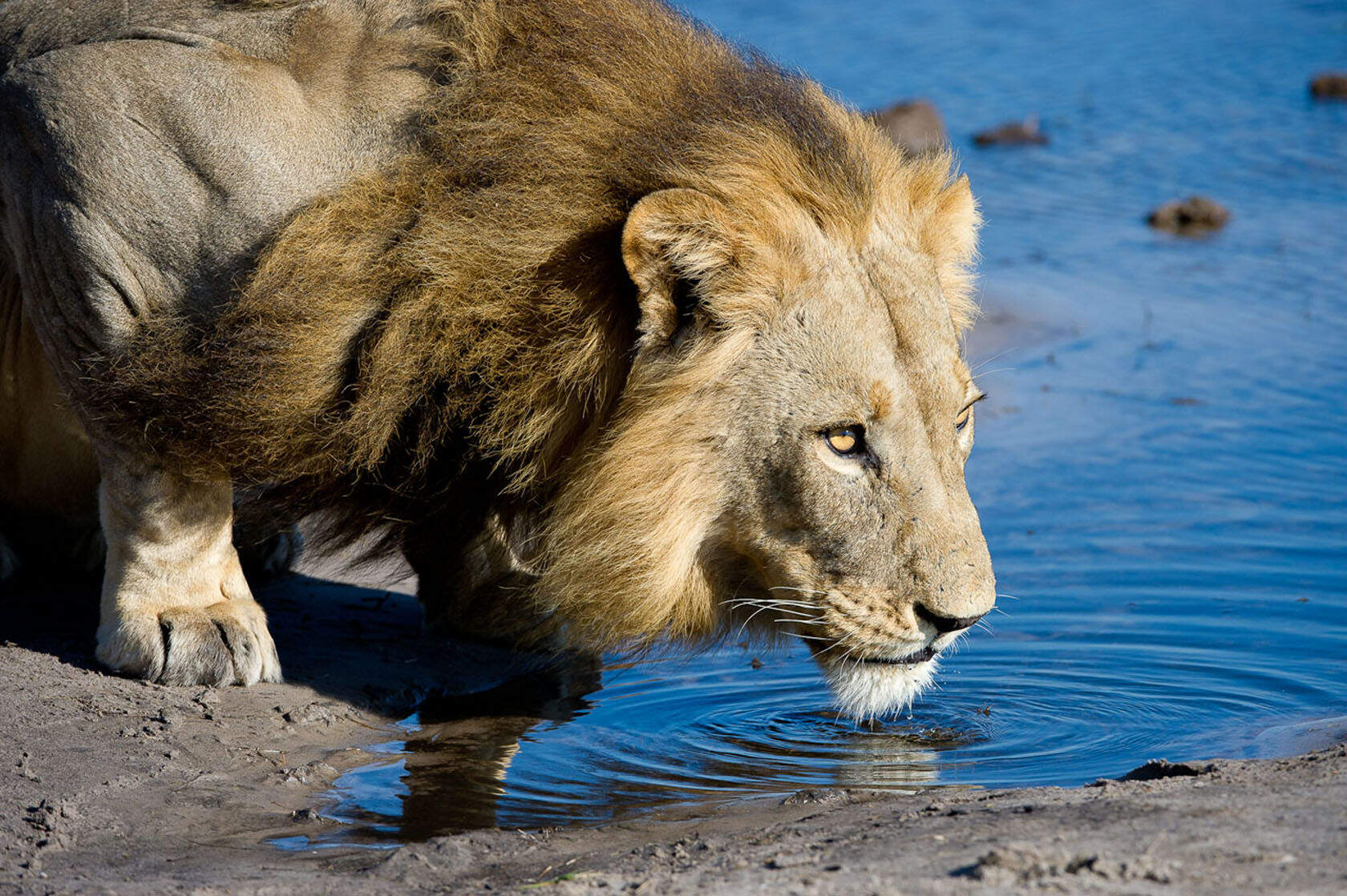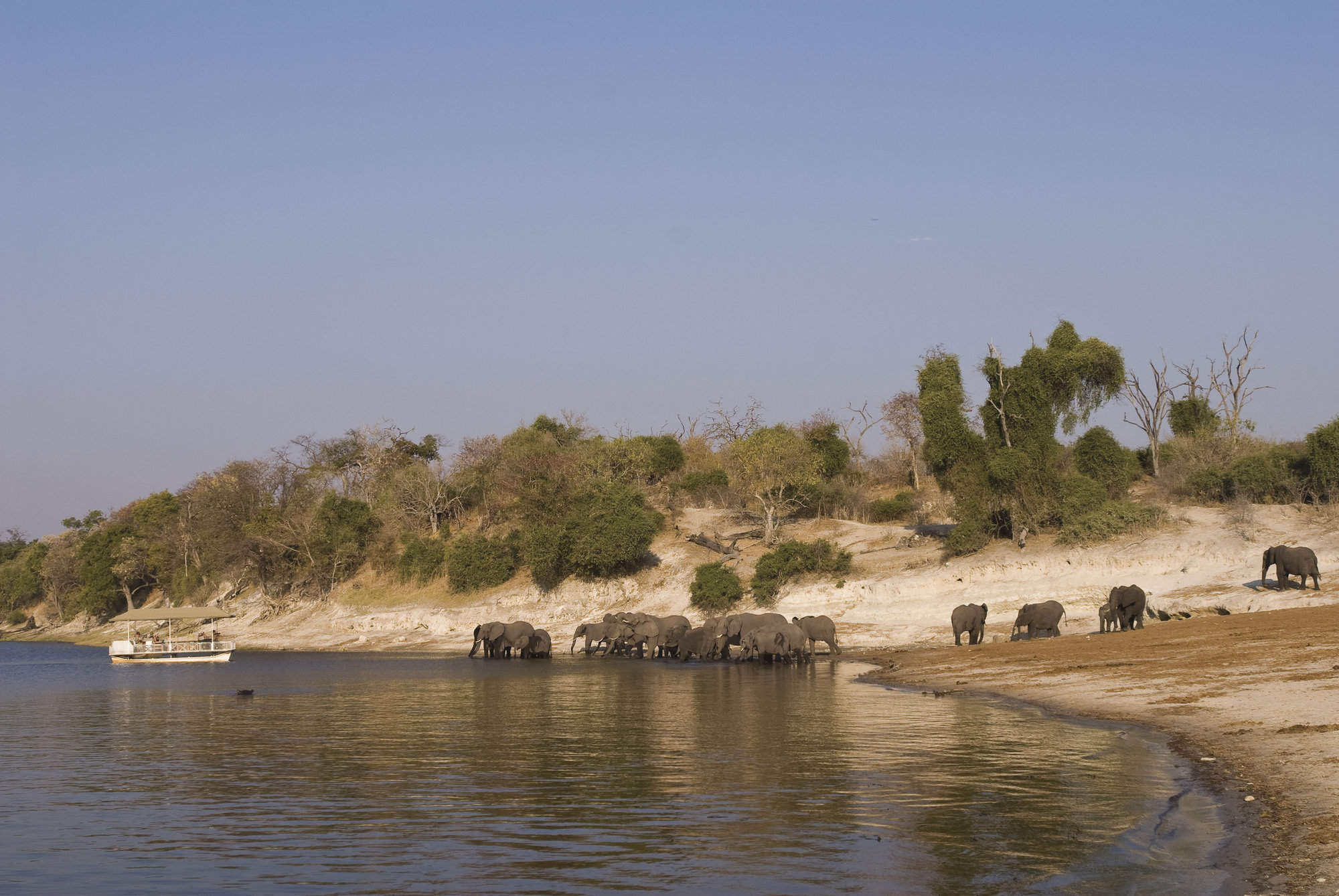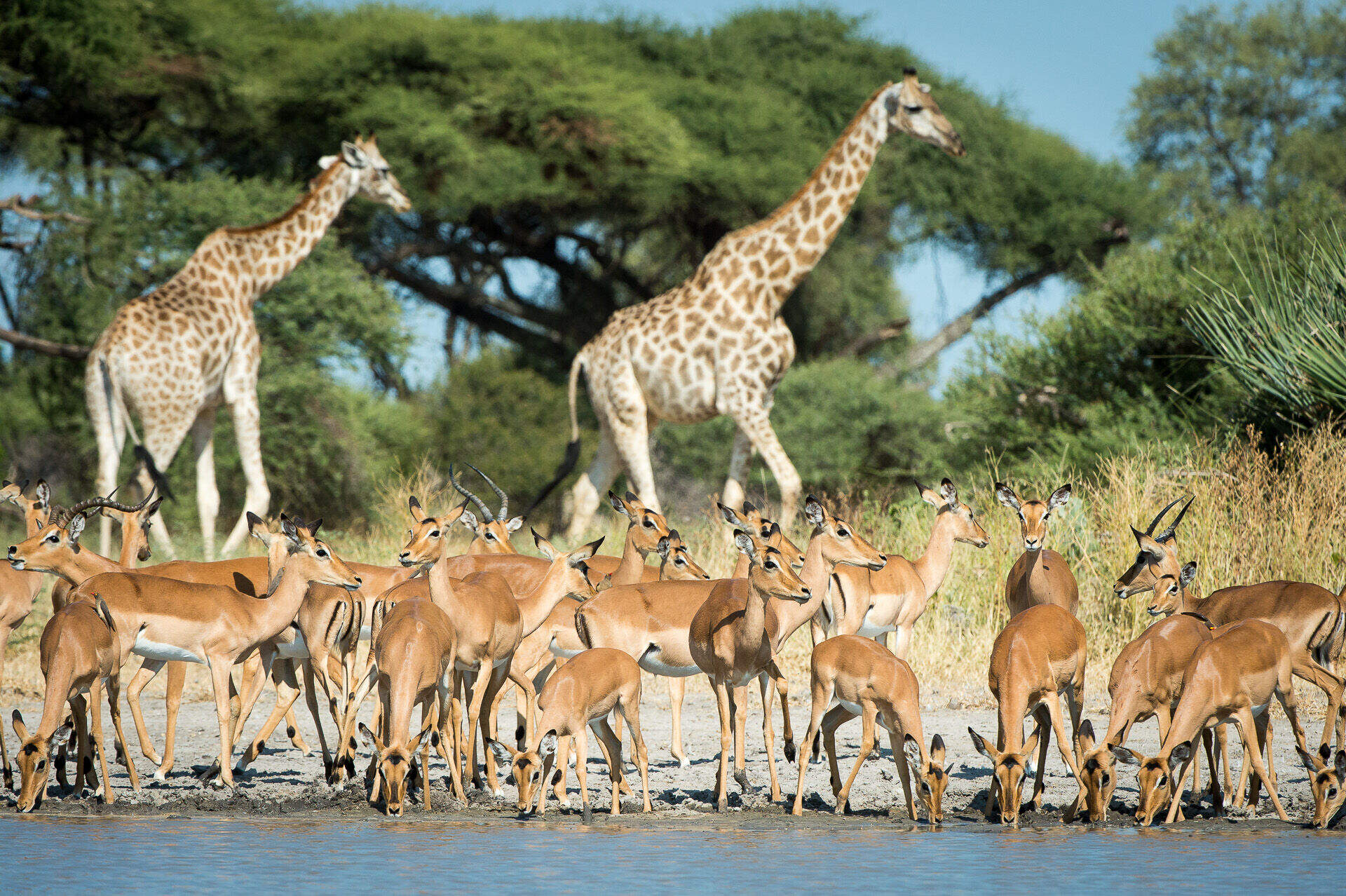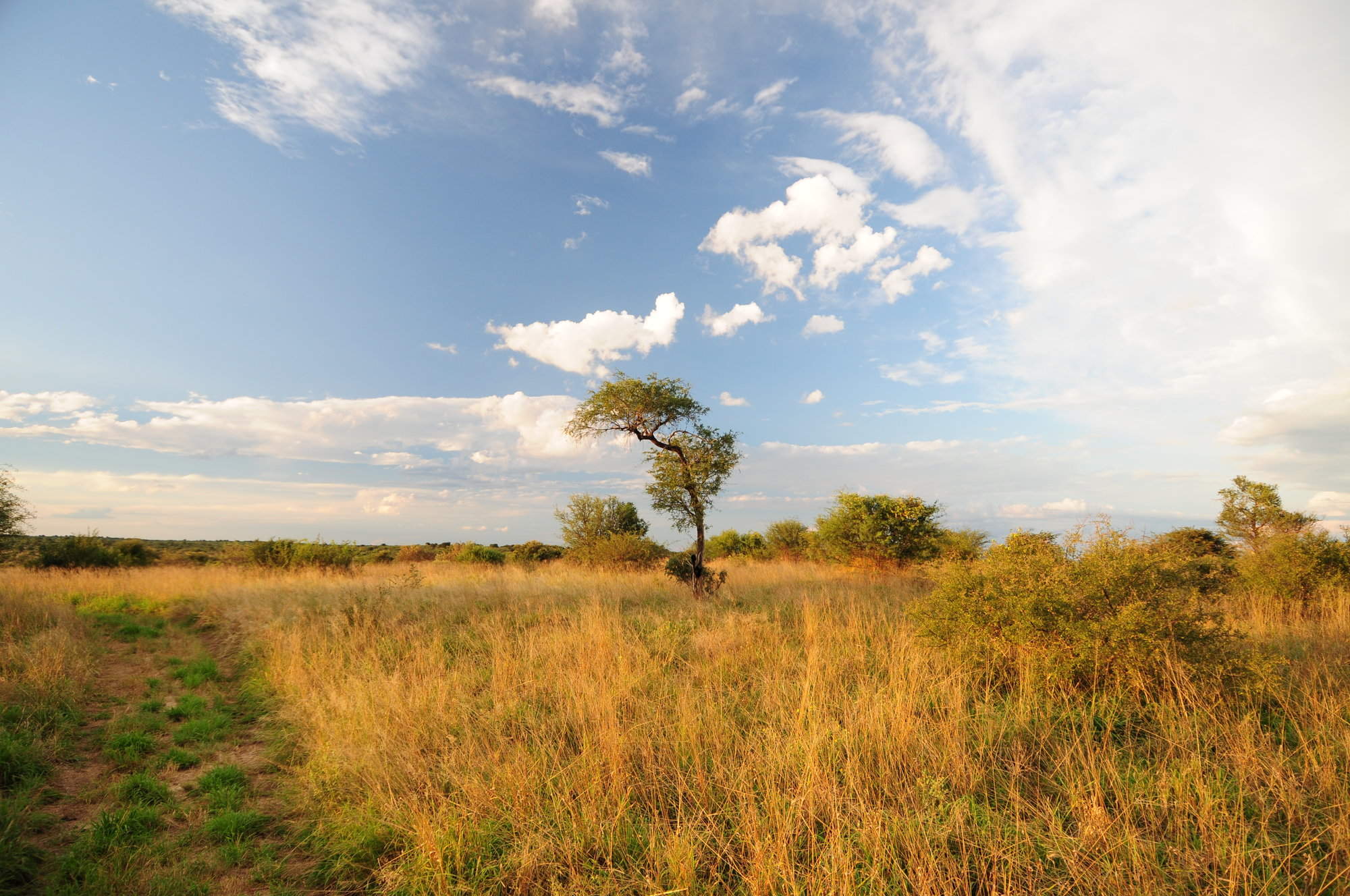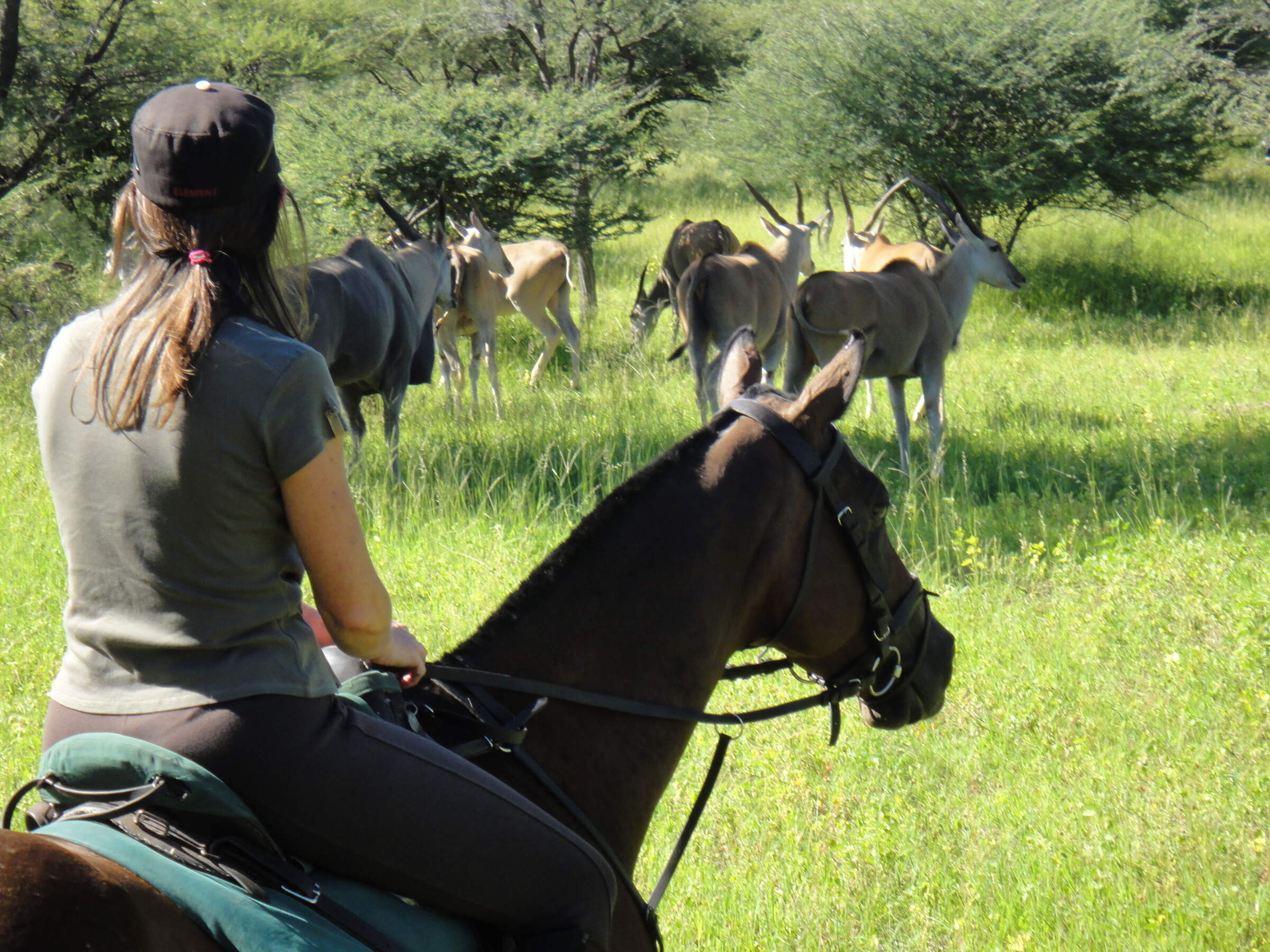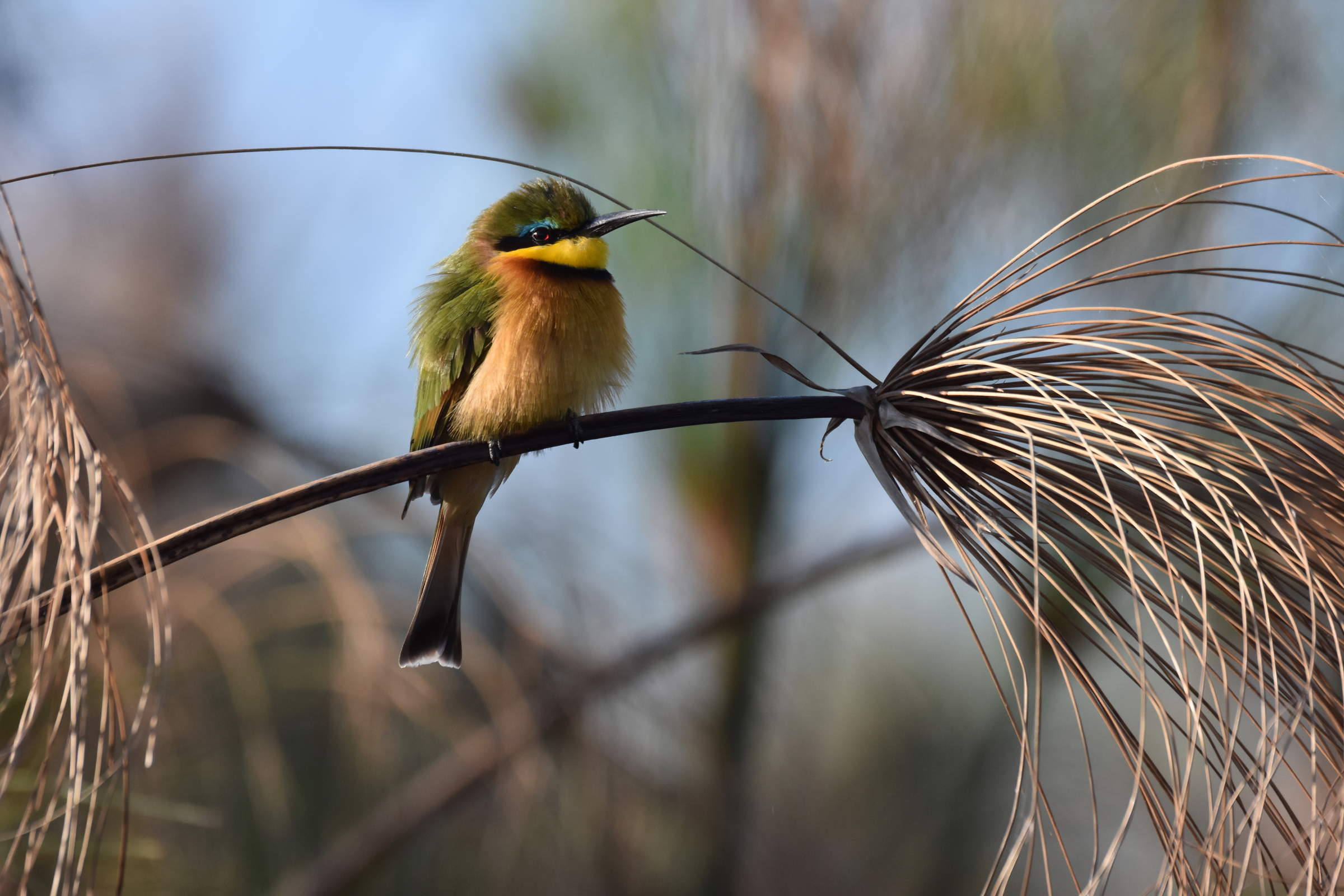Camp Kalahari: Our full report
Camp Kalahari sits on the edge of Botswana's Makgadikgadi Pans on a shrubby outcrop known as Hyena Island.
A relatively simple camp, it makes a convenient and comfortable location from which to explore the salt pans in the dry season or to witness southern Africa's largest migration of zebra and wildebeest when the rains arrive.Camp Kalahari is the simplest of three sister camps in the Makgadikgadi area, the others being Jack's Camp and San Camp. Their activities, however, are similar, so the choice of camp is largely a question of style and cost.
Sandy pathways lead to Camp Kalahari's 11 Meru-style canvas tents. Six of these are twin, four are double and one – designed with families in mind – is effectively one twin and one double tent linked by a large bathroom. The steel-framed, four-poster canopy beds in each tent are quite high off the ground, giving plenty of storage space for luggage underneath. For the summer months, there's a standing fan, while in the winter months, when evening temperatures really drop, we are pleased to say that a hot-water bottle is placed in each bed, ready for your return from dinner. Glasses and a flask of cold drinking water sit on an antique-style desk.
All of the tents are en suite, each bathroom – reached through the back of the tent – housing a toilet and shower. Although these bathrooms are effectively outside, they are screened by wooden palisades and most are covered by gauze netting and flysheets. The exception is the family tent, which has an open-top shower area.
The V-shaped, thatched main area at Camp Kalahari has two “arms” – one housing the dining room, the other the lounge. Both are on very slightly raised, polished concrete bases covered with sisal matting and oriental rugs. Like the rest of the camp, they are decorated with local crafts and furniture, as well as some campaign furniture, redolent of a bygone era of exploration. Old glass cabinets house artefacts (ostrich eggs, animal skulls, silver cups etc), and the walls are adorned with interesting old maps and pictures.
The dining room has one long table and directors' chairs for convivial mealtimes, a help-yourself bar and water cooler (both housed in old-style wooden chests), and a dark wooden sideboard with a permanent tea/coffee station. In the small lounge you'll find a couple of cosy seating areas where red/cream fabric covers the comfy sofas and cushions. A glass-fronted cabinet does service as a small curio shop and there is a multi-adaptor charging station for camera batteries etc.
On the outskirts of the camp, in the dappled shade of a camelthorn tree, is a swimming pool with a thatched, shady area covering a set of deck chairs and a couple of day beds. The location of the pool, away from the thicker foliage, provides a more open feel than the rest of the camp. Although the pool is not large enough to swim laps, it provided welcome relief from the December heat during our last stay in 2023.
Activities from Camp Kalahari and its sister camps are exceptionally varied and, unusually, are typically scheduled at the beginning of your stay. Among them are morning and evening 4WD safaris in and around the Makgadikgadi Pans National Park, often with spotlit night drives on the return to camp in the evenings. Night drives are also offered after dinner, particularly in the dry season (June–October), giving travellers the opportunity to spot nocturnal animals. We understand that it’s fairly common to spot aardvark here although we missed them on our last visit. During the rainy season night drives are only offered on request as the spotlight can attract a lot of insects. On 4WD activities open safari vehicles seat up to six travellers in three rows – giving each person a “window” seat.
A real highlight of both Camp Kalahari and its sister camps is a visit to one of the resident families of meerkat. These have been semi-habituated to humans: while they are wild animals, they more or less ignore visitors. Spending time following the meerkats as they foraged across the Kalahari for grubs, frogs and scorpions was a fascinating experience; they're exceptionally cute, very inquisitive and most will allow you to follow or sit with them at very close proximity. The meerkat family visit was amongst the wildlife highlights of our recent trip to Botswana.
Quadbiking excursions onto the huge Ntwetwe Pan (which covers about 6,500km²) are a real feature of visits to Camp Kalahari in the dry season, from around May to October. Because of the fragility of the pans, quadbiking is possible only during this period, sticking strictly to set tracks. (NB: It's essential that you read the quadbike warning in the 'Health & Safety' section below for our comments on bike helmets and insurance on this activity.)
Horseriding is also available here at additional cost, for both beginners and experienced riders. You can choose between rides of a few hours or – for experienced riders only – a multi-day trip of up to five nights.
The “Bushman experience” at Camp Kalahari is very good too – one of the best of the growing number of similar activities we have taken part in during our visits to Botswana. There's nothing fake about this experience; it's simply a group of men and women of varying ages sharing some of the knowledge passed down by their forefathers on how they have traditionally survived in this wild and harsh environment, and some of the games they have enjoyed, too.
Finally, there is a helicopter based at the nearby Jack's Camp. With space for up to three passengers at a time, the helicopter can be used for transfers (doors on) or scenic helicopter flights (doors off). Scenic flights can range from 15 minutes to much longer trips including visits to Kubu Island, Nata Bird Sanctuary and beyond, often including lunch or a champagne stop. However, please note that all helicopter flights are at an additional, substantial charge.
Sadly, the erstwhile visits to Chapman's Baobab are no longer. This ancient tree was estimated to be about 4,500 to 5,000 years old and in days past, a hole in the trunk was used as a postbox, where mail was left for collection by those passing by. Unfortunately the tree collapsed in January 2016, splitting the trunk, and has since rotted away.
Our view
Camp Kalahari doesn't have the prestige or the refinements of its sister camps, but it offers a similar experience at a more economic price, and it's a bigger camp and an attractive option for travellers with children. The wide range of activities means that no one, young or old, should become bored. And while facilities and meals are less luxurious, the camp can deliver a relaxed and peaceful experience, with a great chance of seeing meerkats.
Geographics
- Location
- Kalahari's Salt Pans, Botswana
- Ideal length of stay
- 3 nights if possible
- Directions
- Camp Kalahari is approximately a 50-minute light-aircraft flight from Maun, followed by a 4WD transfer to camp of roughly 15–20 minutes.
- Accessible by
- Fly-and-Transfer
Food & drink
- Usual board basis
- Full Board & Activities
- Food quality
- When we stayed at Camp Kalahari in December 2023, we enjoyed a range of excellent meals. We understand that with sufficient notice, the camp team can cater for most dietary requirements.
The camp bottles its own “Pillipilli-Hoho”, which is on hand at mealtimes. This blend of chillies, sherry and gin is very fiery but very tasty too. It's a great example of the little personal touches that make Camp Kalahari and its sister camps unique.
Breakfast is typically set out at 5.30am before the morning activity. A continental-style buffet of fruit, cereals, bread and yoghurts is complemented by cooked-to-order options, including eggs, bacon, tomato and toast.
Lunch is served shortly after returning to camp from the morning activity, usually around 11.00am. During our stay, we enjoyed an excellent and beautifully presented salad niçoise followed by a cheese platter.
After a siesta and before the afternoon activity, it’s time for high tea, though the precise timing will vary depending on the activity. We tucked into cucumber sandwiches, freshly made sausage rolls, carrot cake and sliced watermelon.
In the evening, dinner is usually served at around 8.00pm (though orders for main courses are usually taken at lunchtime). We started with green vegetable soup with a fresh bread roll, followed by a choice of lamb tagine with couscous, beef fillet with potato galette or a potato and halloumi bake. Our meal was rounded off with a sticky date pudding. - Dining style
- Group Meals
- Dining locations
- Indoor and Outdoor Dining
- Further dining info, including room service
- Private meals can be arranged on request.
- Drinks included
- There is a well-stocked bar from which all drinks – bottled water, soft drinks, local beers, spirits and a selection of (generally) South African wines – are included in the rates. Special or exotic drinks can be ordered in with advance notice, at additional cost.
Special interests
- Family holidays
- Quadbiking across Botwana's Kalahari saltpans and a fascinating Bushman experience make for memorable family safari holidays at Camp Kalahari. Visiting the habituated families of meerkats here is another highlight for children and adults alike.
- See ideas for Family holidays
- Riding holidays
- The exceptional scenery around Camp Kalahari makes a stunning backdrop for horseriding in Botswana. Horseback safaris, suitable for a range of riding abilities, last from a few hours to up to five nights.
- See ideas for Riding holidays
- Cultural experiences
- Camp Kalahari offers a fascinating and authentic walk with Bushmen, which we consider to be one of the best cultural experiences in Botswana. You'll go out with Bushmen guides, looking at the surrounding flora and fauna, and hearing about their traditional culture.
- See ideas for Cultural experiences
- Wildlife safaris
- For a wildlife safari in Botswana, Camp Kalahari is pretty unusual. Visiting one of the families of habituated meerkats is an exceptional experience. Lion, brown hyena and other predators frequent this area, and during the rainy season, zebra can sometimes be seen here in their thousands, along with many wildebeest.
- See ideas for Wildlife safaris
- Walking
- It may not be classic walking, but our team rate the Bushman walks at Camp Kalahari as some of the best on offer. The Bushmen explain how they have survived over millennia using knowledge passed down to them through the generations. We found this fascinating.
- See ideas for Walking
Children
- Attitude towards children
- Camp Kalahari welcomes children of all ages. There is a family tent accommodating two adults and two children.
- Property’s age restrictions
- Children under the age of 12 years are not allowed to drive the quadbikes, but younger children may accompany an adult.
- Special activities & services
- None
- Equipment
- None
- Generally recommended for children
- Camp Kalahari caters well for slightly older children. It makes a fantastic family safari destination, and children love the meerkats. Unlike at Jack's and San camps, families with younger children are not required to take a private vehicle.
- Notes
- The salt pans are not home to prolific game, but lion, elephant and other dangerous animals (such as honey badgers) do sometimes pass through the camp, despite an electric fence. Children should always be closely supervised by a responsible adult.
Our travellers’ wildlife sightings from Camp Kalahari
Since mid-2018, many of our travellers who stayed at Camp Kalahari have kindly recorded their wildlife sightings and shared them with us. The results are below. Click an animal to see more, and here to see more on our methodology.

100% success

100% success

94% success

81% success

67% success

47% success

36% success

29% success

23% success

13% success

0% success

0% success

0% success

0% success
Communications
- Power supply notes
- Electricity is provided by a combination of solar power and generator.
Universal charging sockets are available in the tents and the main area and should allow travellers to charge most electrical items 24/7. - Communications
- Limited WiFi is available in camp with the strongest reception in the pool area.
- TV & radio
- None
- Water supply
- Borehole
- Water supply notes
- All the rooms are plumbed and have flush toilets.
Health & safety
- Malarial protection recommended
- Yes
- Medical care
- The senior camp staff are first-aid trained. The nearest doctors are a short flight away in Maun or Francistown. In the event of a serious emergency, guests would be airlifted to Johannesburg. Please note that it is only possible to fly out of camp during daylight hours as the bush airstrips do not have any lighting at night.
Quadbike warning: With an abundance of caution, we feel that it's important to let prospective travellers know that although safety helmets are provided for the quadbike activities at Camp Kalahari and its sister camps, San Camp or Jack's Camp, there is scant mention of them by staff. They are usually left hanging on a post at the side with the guides just demonstrating how to use the kikoi as a head wrap. We would very much recommend that you ask to use one of the helmets for your personal safety.
We understand that the camps have operated quadbikes regularly here since 1992, and that at the time of writing there has never been a serious accident. The camps regard this activity to be safe, even without helmets, especially as they generally keep to specific tracks and don't speed; and that the area is largely flat and free of other traffic. We're not aware of any of our travellers having any problems over the years prior to helmets being introduced in 2016, and all of our team members who have visited have enjoyed quadbiking activities in the past without any problems or concerns.
If you are concerned about the safety aspects of this activity, please tell us very clearly and specifically in writing, before you travel, and request that we confirm to you in writing that we have arranged for you to be driven across the pans in a vehicle instead of using a quadbike. If you leave this decision until you're at camp, and then choose not to do the quadbike activity, alternative arrangements may not be possible. Although, of course, you could always omit this activity, and relax around the camp and swimming pool instead. (Sadly, refunds aren't possible if you choose to miss activities like this at a camp.)
As with any activity, please check the details of your travel insurance to ensure that you are fully covered in the case of a quadbiking accident. Be aware, too, that some insurances will provide cover for bikes up to a certain engine power, but not beyond, so you need to check such clauses particularly carefully. - Dangerous animals
- High Risk
- Security measures
- Guests are escorted to their tents after dark. Guides’ and managers’ accommodation is close by and an airhorn is provided in the tents for attracting attention in the event of an emergency at night.
- Fire safety
- There are fire extinguishers in all the tents and in the main area. Fire hoses were also being installed at the time of our last stay in December 2023.
Activities
4WD Safari
Birdwatching
Cultural excursion
Fly-camping
Guided walking safari
Night drive
Quad-biking
Sleeping under the stars
Extras
- Disabled access
- On Request
- Laundry facilities
- A laundry service is included – excluding underwear for which washing detergent is provided in each tent.
- Money
- There is a digital safe in each tent. Currency exchange is not available.
- Accepted payment on location
- Mastercard and Visa credit cards are accepted; Amex and Diners are not. Cash payments may be made in GB pounds, US dollars, euros, South African rand and Botswana pula.
Other lodges in Kalahari's Salt Pans
Alternative places to stay in this same area.
